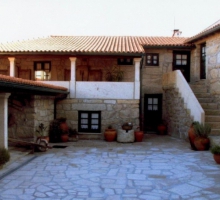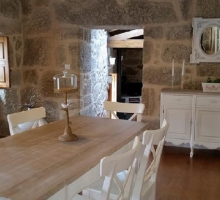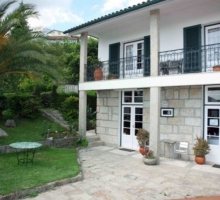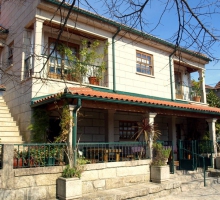The Glaciar and the Alto Vez’ Track is a pedestrian path denominated Small Route (PR), marked and signalized according to the International Guidelines. This route is located on the north side of the “Serra da Peneda” (Peneda’s Hill), in the extreme northwest of the mountain of the Arcos de Valdevez’s county, involving the Sistelo’s area, and traversing part of the Porto Cova’s place. Starting in the parking place next to the picturesque village, we follow the road down to the river with the same name. As we move, we observe several landscape elements of singular beauty that contribute to the enrichment of this mountain region’s heritage.
It is worth highlighting the monumental agro-pastoral-forest set constituted of the housing units, the terraces, the irrigation system, the cereals warehouses, the threshing floors and the sidewalks, being considered one of the most important in Europe. Traversing the trucker, hence called because was the crossing of the oxcarts, we can observe the peculiar geological shapes of granite blocks surrounding the landscape - the track and all its surroundings are occupied by two types of granitic rocks: the granite of the “Serra Amarela (Yellow Hill) and Extremo (Extreme)” granite. Gradually, we enter into the “Serra da Peneda Glacial Valley”. Hereabout, been ancient extinct glacial for thousands of years, which was formed by huge masses of ice, which by gravity, slowly, were shaping the mountain's surface, forming the characteristic U-shaped valleys.
The materials carried by the glacial, were grouped into lined sediments called moraines. Mostly on the right bank of the River Vez, with an appearance faceted polished, irregular and large blocks of granite, dragged by the glacial along its way, stands out in the landscape. The rich and diversified number of geomorphological traces from the Glacial Period existing here, contributed to the formation of a beautiful and unique landscape.
After passing the Branda do Furado, where you can observe the schists, the metasedimentary rocks, we continue to climb along the way paved, to get to the “Chã” and its superb wide area of the “Alto Minho” landscape. Sometime after, reaching the Branda’s culture set - Branda Outeiro Gordo, Branda Costa do Salgueiro e a Branda da Lapinheira -, consisting of small clusters of scattered buildings and small fields, we follow till the Castribô’s Branda, also cultivatable. This Branda, now almost abandoned, is in a singular beauty area, surrounded by mountain pastures, it is an excellent shelter for men and animals. Leaving behind the branda, we continue our journey on a route stippled by mountain oak stains (Quercus Robur). Finally, we find the Porto Cova’s place, exactly where this track began at the Glacial and the Alto Vez.
Points of interest:
Comunidade Rural de Porto Cova
Penedo de Valbom
Branda do Furado
Panoramic view over the “Glaciar Valley”
Complexo de Brandas
Branda de Castribô
Panoramic view over Sistelo’ village
Typology: Small Route
Length: 12, 8 km
Duration (hours – approximate): 5h00
Type of tread: Sidewalks and trucker’s ways
Degree of difficulty: moderate
Starting point: Porto Cova – Sistelo’ village
Arrival: Porto Cova – Sistelo’ village
Location: Arcos de Valdevez
It is worth highlighting the monumental agro-pastoral-forest set constituted of the housing units, the terraces, the irrigation system, the cereals warehouses, the threshing floors and the sidewalks, being considered one of the most important in Europe. Traversing the trucker, hence called because was the crossing of the oxcarts, we can observe the peculiar geological shapes of granite blocks surrounding the landscape - the track and all its surroundings are occupied by two types of granitic rocks: the granite of the “Serra Amarela (Yellow Hill) and Extremo (Extreme)” granite. Gradually, we enter into the “Serra da Peneda Glacial Valley”. Hereabout, been ancient extinct glacial for thousands of years, which was formed by huge masses of ice, which by gravity, slowly, were shaping the mountain's surface, forming the characteristic U-shaped valleys.
The materials carried by the glacial, were grouped into lined sediments called moraines. Mostly on the right bank of the River Vez, with an appearance faceted polished, irregular and large blocks of granite, dragged by the glacial along its way, stands out in the landscape. The rich and diversified number of geomorphological traces from the Glacial Period existing here, contributed to the formation of a beautiful and unique landscape.
After passing the Branda do Furado, where you can observe the schists, the metasedimentary rocks, we continue to climb along the way paved, to get to the “Chã” and its superb wide area of the “Alto Minho” landscape. Sometime after, reaching the Branda’s culture set - Branda Outeiro Gordo, Branda Costa do Salgueiro e a Branda da Lapinheira -, consisting of small clusters of scattered buildings and small fields, we follow till the Castribô’s Branda, also cultivatable. This Branda, now almost abandoned, is in a singular beauty area, surrounded by mountain pastures, it is an excellent shelter for men and animals. Leaving behind the branda, we continue our journey on a route stippled by mountain oak stains (Quercus Robur). Finally, we find the Porto Cova’s place, exactly where this track began at the Glacial and the Alto Vez.
Points of interest:
Comunidade Rural de Porto Cova
Penedo de Valbom
Branda do Furado
Panoramic view over the “Glaciar Valley”
Complexo de Brandas
Branda de Castribô
Panoramic view over Sistelo’ village
Typology: Small Route
Length: 12, 8 km
Duration (hours – approximate): 5h00
Type of tread: Sidewalks and trucker’s ways
Degree of difficulty: moderate
Starting point: Porto Cova – Sistelo’ village
Arrival: Porto Cova – Sistelo’ village
Location: Arcos de Valdevez






